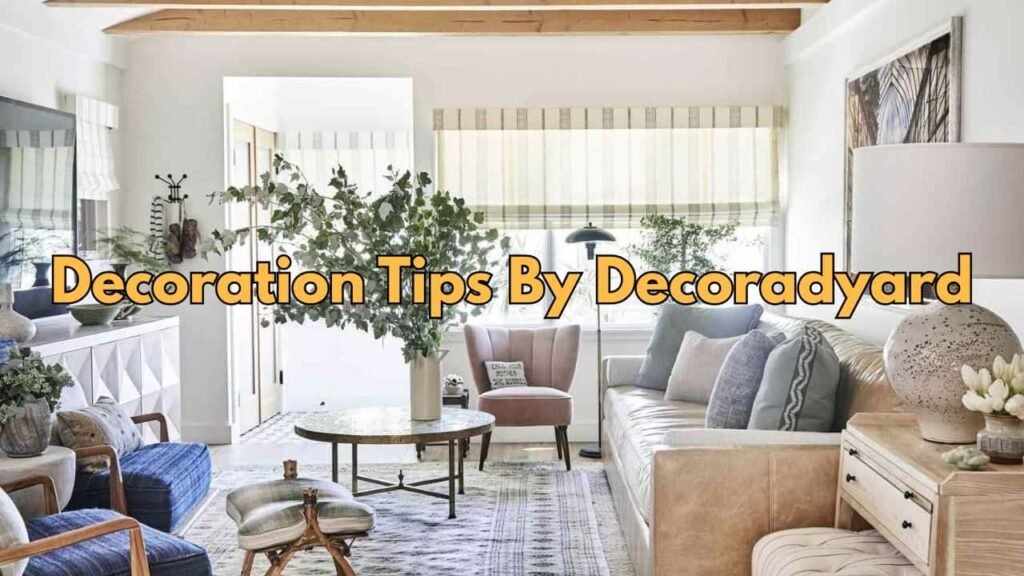Introduction
Your yard is more than grass and fences — it’s the first impression of your home and a space where memories are made. Whether you dream of a cozy garden corner, a kid-friendly play space, or an elegant outdoor entertaining area, yard decorating can completely transform the way you live outdoors.
Many people hesitate because they think decorating requires a huge budget or expert landscapers. But with smart planning and a few simple strategies, anyone can decoradyard (decorate their yard) beautifully. From selecting the right plants and furniture to adding lighting, pathways, and artful accents, this guide covers everything you need to create an inviting, low-maintenance yard that reflects your style.
Let’s walk step by step through proven design principles, practical ideas, and creative touches to help you make your outdoor space a place you love.
Read More: What Is Decoradyard & How to Use It (2025 Guide)
Step 1: Assess Your Yard & Define Goals
Before you buy furniture or plants, step outside and study your yard carefully.
-
Measure and sketch: Draw a simple map of your yard with key features (trees, patios, sheds, fences).
-
Check sunlight: Track where sunlight falls during the day. Some areas may get full sun, while others remain shaded.
-
Soil type & drainage: Clay, sandy, or loamy soil all affect what you can grow successfully.
-
List needs: Do you want a play area, a dining space, or a relaxing retreat? Write down your priorities.
-
Decide on style: Modern minimalist? Rustic cottage? Tropical paradise? Choosing a style early prevents random mismatched purchases.
-
Set a budget: Even a small budget can go far with smart choices.
This planning stage saves money, avoids clutter, and ensures your design feels intentional.
Step 2: Build the Framework with Hardscape
Hardscape — the non-plant structures in your yard — sets the backbone of your design.
-
Pathways: Create natural flow using stone, gravel, or stepping stones. Curved paths feel organic; straight paths suit modern styles.
-
Patios & decks: These anchor your outdoor living area. Choose materials like pavers, wood, or composite decking.
-
Borders & edging: Define planting beds with bricks, stones, or metal edging for a crisp finish.
-
Privacy & structures: Add pergolas, trellises, or lattice screens for both shade and decorative charm.
-
Levels & terraces: In sloped yards, retaining walls or steps can create usable zones.
Think of hardscape as the “bones” of your outdoor space — strong, functional, and supportive. Once set, plants and decorations can enhance it.
Step 3: Choose the Right Plants
Plants are the soul of any yard. Choosing wisely ensures beauty with manageable upkeep.
-
Layering: Place tall trees/shrubs in the back, medium plants in the middle, and low flowers or groundcovers in front.
-
Seasonal mix: Combine evergreen plants (year-round structure) with seasonal blooms for color throughout the year.
-
Repetition: Repeat plant species in different spots to create unity.
-
Color harmony: Stick to 2–3 main colors plus greenery for a cohesive palette.
-
Native & drought-tolerant: Save water and effort by using plants adapted to your climate.
-
Containers: Add decorative pots near entrances, patios, or steps to highlight corners.
For example: lavender + ornamental grasses + evergreens = texture, fragrance, and year-round appeal.
Step 4: Add Functional Furniture
Outdoor furniture isn’t just seating — it defines how you’ll use your yard.
-
Dining sets: Great for family meals outdoors.
-
Lounge chairs or hammocks: Perfect for relaxation zones.
-
Benches: Provide simple seating and act as decor.
-
Movable stools or poufs: Flexible for gatherings.
Choose durable, weather-resistant materials (metal, treated wood, resin wicker). Always test comfort before buying — usability matters as much as looks.
Step 5: Accents & Decorative Elements
This is where creativity shines. A few well-chosen accents can transform the atmosphere.
-
Lighting: String lights, lanterns, path lights, and spotlights for evening charm.
-
Water features: Fountains, ponds, or birdbaths add calming sound and attract wildlife.
-
Garden art: Sculptures, mosaic stepping stones, or wall decor personalize the space.
-
Vertical interest: Trellises with vines, hanging planters, or garden mirrors expand visual depth.
-
Wind chimes & mobiles: Add sound and movement.
Tip: Less is more. Too many accents can look cluttered. Choose a few meaningful pieces.
Step 6: Focus on Flow & Focal Points
A well-decorated yard feels intentional, not random.
-
Sightlines: Place focal points where the eye naturally travels — a sculpture, a tree, or a seating nook.
-
Transitions: Use plants or groundcover to soften changes between spaces.
-
Balanced zones: Keep seating, play, and planting areas proportionate to yard size.
-
Coherence: Repeat colors, materials, or plants across zones for unity.
Step 7: Maintenance & Seasonal Care
No yard stays beautiful without care — but planning ahead makes it easier.
-
Mulching: Keeps soil moist and suppresses weeds.
-
Irrigation: Use drip systems or soaker hoses for efficiency.
-
Seasonal updates: Swap container plants each season for fresh color.
-
Pruning schedule: Regularly trim shrubs, deadhead flowers, and clean paths.
-
Furniture care: Cover or store outdoor furniture in bad weather.
Smart design = less maintenance and more enjoyment.
Common Yard Decorating Mistakes to Avoid
-
Overcrowding: Too many plants or decor items = chaos.
-
Ignoring climate: Buying unsuitable plants or materials wastes money.
-
No lighting: Your yard should be usable after sunset.
-
Disorganized style: Mixing rustic, modern, and tropical elements randomly feels messy.
-
Neglecting comfort: Pretty but uncomfortable furniture won’t get used.
Sample Yard Transformation (Scenario)
Imagine a small suburban yard:
-
Hardscape: A paved patio with string lights overhead.
-
Plants: A border of evergreens, lavender, and ornamental grasses.
-
Furniture: A compact bistro table with two chairs.
-
Accents: A ceramic water fountain and three large terracotta planters near the entry.
-
Flow: A stepping-stone path curves to the seating area.
The result? A simple, stylish, low-maintenance yard perfect for evening relaxation.
Read More: Smart & Stylish Home Hacks for Modern Living
Conclusion
Decorating your yard doesn’t have to be overwhelming or expensive. With clear planning, smart plant choices, and a balance of structure and style, you can transform any outdoor space into a welcoming extension of your home. Begin by mapping out your yard, setting goals, and installing the framework with paths, patios, and privacy structures. Then bring life with layered plants, durable furniture, and a few carefully chosen accents like lighting or a water feature. Keep sightlines clear, flows natural, and maintenance manageable.
Whether you want a peaceful retreat, a family play space, or an elegant entertaining area, the strategies in this guide can help you achieve it. Step outside with fresh eyes, take small but intentional actions, and watch your yard evolve into a beautiful, functional place you’ll love for years.
FAQs
1. How can I start decorating my yard on a budget?
Begin with basics: clear clutter, mow, edge lawns, and add mulch. Use affordable plants like perennials or native species. Repurpose items (old pots, crates) as planters and start small with one focal corner.
2. What are the easiest low-maintenance plants for yards?
Evergreens (boxwood, juniper), ornamental grasses, succulents, and native shrubs. These need less water and pruning while staying attractive year-round.
3. How can I decorate a small yard to make it look bigger?
Use vertical elements (trellises, wall planters), mirrors to reflect space, and curved pathways. Stick to a light color palette and avoid bulky furniture.
4. What’s the best lighting for yard decoration?
Combine solar path lights, string lights for ambiance, and spotlights for focal features. LED options save energy and last longer.
5. How do I keep my decorated yard looking fresh year-round?
Mix evergreen plants with seasonal flowers, rotate container plants, refresh mulch annually, and update accent pieces like cushions or lanterns seasonally.










